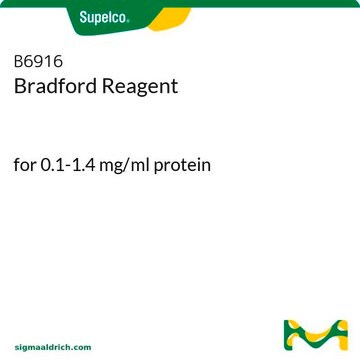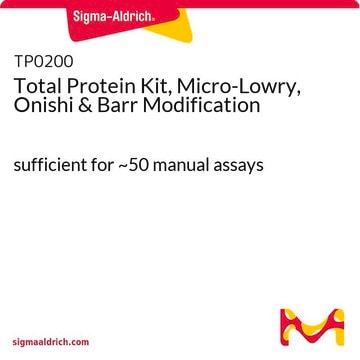Products may be shipped at a different temperature than the recommended long-term storage temperature. If the product quality is sensitive to short-term exposure to conditions other than the recommended long-term storage, it will be shipped on wet or dry-ice. If the product quality is NOT affected by short-term exposure to conditions other than the recommended long-term storage, it will be shipped at ambient temperature. As shipping routes are configured for minimum transit times, shipping at ambient temperature helps control shipping costs for our customers. For more information, please refer to the Storage and Transport Conditions document: https://www.sigmaaldrich.com/deepweb/assets/sigmaaldrich/marketing/global/documents/316/622/storage-transport-conditions-mk.pdf
Kluczowe dokumenty
47641
Folin & Ciocalteu′s phenol reagent
2 M (with respect to acid)
Synonim(y):
Roztwór fenolowy Folin-Ciocalteu
Wybierz wielkość
243,00 zł
Wybierz wielkość
About This Item
243,00 zł
Polecane produkty
Szukasz podobnych produktów? Odwiedź Przewodnik dotyczący porównywania produktów
Zastosowanie
Inne uwagi
Hasło ostrzegawcze
Danger
Zwroty wskazujące rodzaj zagrożenia
Zwroty wskazujące środki ostrożności
Klasyfikacja zagrożeń
Eye Dam. 1 - Met. Corr. 1 - Skin Corr. 1
Kod klasy składowania
8A - Combustible corrosive hazardous materials
Klasa zagrożenia wodnego (WGK)
WGK 1
Temperatura zapłonu (°F)
Not applicable
Temperatura zapłonu (°C)
Not applicable
Środki ochrony indywidualnej
Faceshields, Gloves, Goggles, type ABEK (EN14387) respirator filter
Wybierz jedną z najnowszych wersji:
Masz już ten produkt?
Dokumenty związane z niedawno zakupionymi produktami zostały zamieszczone w Bibliotece dokumentów.
Klienci oglądali również te produkty
-
How is shipping temperature determined? And how is it related to the product storage temperature?
1 answer-
Helpful?
-
-
How can I determine the shelf life / expiration / retest date of this product?
1 answer-
If this product has an expiration or retest date, it will be shown on the Certificate of Analysis (COA, CofA). If there is no retest or expiration date listed on the product's COA, we do not have suitable stability data to determine a shelf life. For these products, the only date on the COA will be the release date; a retest, expiration, or use-by-date will not be displayed.
For all products, we recommend handling per defined conditions as printed in our product literature and website product descriptions. We recommend that products should be routinely inspected by customers to ensure they perform as expected.
For products without retest or expiration dates, our standard warranty of 1 year from the date of shipment is applicable.
For more information, please refer to the Product Dating Information document: https://www.sigmaaldrich.com/deepweb/assets/sigmaaldrich/marketing/global/documents/449/386/product-dating-information-mk.pdfHelpful?
-
-
Which Folin-Coicalteau Regent is suitable for determination of total phenolic content in plant extracts?
1 answer-
Unfortunately, there is no Folin-Coicalteu's reagent available that is specifically tested and recommended for use with plant tissue. However, this product has been cited in several publications for determining the phenolic content in various plant types. Suitability would have to be determined by the end user. Please see the links below to review this publications:
https://www.sciencedirect.com/science/article/pii/S2225411018300130
https://pubs.acs.org/doi/10.1021/jf034743q
https://www.publish.csiro.au/fp/fp05305
https://www.researchgate.net/publication/259874665_Surface_functionalization_of_bioactive_glasses_with_natural_molecules_of_biological_significance_part_II_Grafting_of_polyphenols_extracted_from_grape_skinPlease see the following link to review the product datasheet:
https://www.sigmaaldrich.com/deepweb/assets/sigmaaldrich/product/documents/288/844/47641dat.pdfHelpful?
-
-
Which Follin-ciocalteu reagent is suitable for detection of Phenolic content in fermented beverages?
1 answer-
Folin & Ciocalteu's phenol reagent has been used for the estimation of total phenolic and flavonoids contents in fermented beverages. Please refer to this article, https://www.sciencedirect.com/science/article/pii/S0169433213018151
Helpful?
-
Active Filters
Nasz zespół naukowców ma doświadczenie we wszystkich obszarach badań, w tym w naukach przyrodniczych, materiałoznawstwie, syntezie chemicznej, chromatografii, analityce i wielu innych dziedzinach.
Skontaktuj się z zespołem ds. pomocy technicznej












